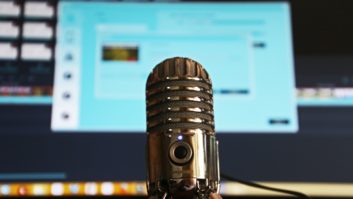The saga continues. It’s remarkable that the development of the IBOC system began well over 20 years ago, yet it still seems to be an ongoing experiment.
On the AM side, the experiment seems to be pretty much concluded: The ship has sprung a leak and is listing badly.
The number of AM IBOC stations plateaued several years ago and now appears to be slowly declining. The system was torpedoed by poor nighttime performance, interference problems and the lack of any real selling point, like new audio services.

Barry McLarnon And now we have the specter of an FM IBOC power increase. There are those who will claim that a power increase was always in the cards, but that is not the case.
Go back and look at all the system documentation put forward by iBiquity and the NRSC back in 2001, and you’ll find no hint that a future digital power increase would be either feasible or desirable, except for the obvious increase that would occur in a transition from the hybrid system to an all-digital system.
In fact, the field trial data presented to the FCC at that time claimed very good digital coverage, out to the 45–50 dBu contours. A closer inspection of the data showed some dropouts in the mobile tests, but that was no problem, thanks to the blend-to-analog backup.
The question of optimum digital power level for FM IBOC was studied quite thoroughly back in the 1990s, and it was shown that levels higher than –20 dBc had considerable potential to cause serious interference — not just to adjacent-channel stations, but to the host station itself. In fact, when iBiquity submitted the system description to the ITU, it was stated that the power level was –22 dBc; this was later tweaked upwards for the system that was evaluated and presented to the FCC.
The game-changer came several years after the system got FCC approval, when NPR, anxious to get more of their programming onto the airwaves, demonstrated the feasibility of carving up the 96 kilobits-per-second digital payload into multiple audio streams. The commercial folks quickly jumped on this concept, as it represented a means of stimulating interest in a public that up to that point had greeted “HD” radio with a collective yawn.
The advent of “HD2” and “HD3” audio streams represented a fundamental change in the system concept. It was certainly a step forward in terms of versatility, but a major shortcoming quickly became evident: Those dropouts that were easily smoothed over in the main audio channel became irritating muting events in the HD2/HD3 streams. Increasing digital power is the only way to reduce the incidence of these dropouts … so, here we are.
A ‘hands-off policy’
The FCC order regarding the power increase represents a bit of a departure for the commission. Up to this point, they at least paid lip service to protecting the public interest by requesting comments at key junctures in IBOC deployment.
This time, however, they based their decision almost entirely on the contents of a report submitted after the close of the comment and reply comment periods. What also raises eyebrows is the fact that the order discusses a couple of ex parte filings submitted after comments were no longer invited.
So, in essence, a few privileged parties had their say at that point, and everyone else was left out in the cold. Not that it would have made any difference had the commission extended the comment period.
Throughout this process, their stance could be summarized as: Let the industry do what it wants in the radio broadcast bands — just don’t come to us looking for any new spectrum.
Trouble is, the “industry” in this case was not all radio broadcasters, but a few well-heeled players, many of whom have a vested interest in the sole source of the proprietary IBOC technology.
The commission has also, it seems, maintained a hands-off policy when it comes to IBOC interference complaints. They claim that there have been no formal complaints about FM IBOC, but there have been many interference situations disclosed in filings on Docket 99-325, as well as on various forums such as Internet mailing lists.
The commission’s attitude can be clearly seen in their reaction to the formal complaint lodged by WYSL(AM), Rochester, N.Y., about AM IBOC interference, which was to ignore it completely. Going forward, one can expect this attitude to persist, and it will be up to the stations concerned to sort out the problems, if they can.
As always, it will be challenging to come up with well-documented interference complaints, since digital interference is indistinguishable from noise. And it will be doubly difficult if the offending stations are unwilling to conduct coordinated tests at different digital power levels.
In this latest episode in the continuing saga, the most surprising aspect has been the about-face by NPR.
In their 2008 report, they warned of dire consequences that would ensue from a blanket FM IBOC power increase. They had plenty of statistics to back this up, derived from studies of numerous stations, using sophisticated propagation prediction tools. According to these results, there were some significant interference problems even at the existing –20 dBc power level.
But then another study is hastily done, and now we’re told: Oops, our mistake, a blanket increase of 6 dB is actually just fine, and even a 10 dB increase will be okay in most cases.
So, what changed? In their 2008 report, NPR based their analysis on lab test results showing the impact of adjacent-channel IBOC interference on FM receivers. In their 2009 report, they disclosed new results gathered in field tests, with the significant departure that the subjective testing phase also took place in moving vehicles.
Were these results wildly different from the earlier findings? Not really. The key result from the new report is a formula for calculating a station’s permissible power increase, based on the D/U ratio that the station creates at the protected contour of its closest first adjacent neighbor.
Power calculator
The D/U ratio is a familiar concept to those involved in FM allocations: the “D” is the field strength (at 30 ft height) of the neighbor station at its protected contour (usually 60 dBu), as predicted by the FCC F(50,50) curves, and “U” is the field strength of the interfering station at the contour, in the direction of that station, calculated according to the FCC F(50,10) curves.
NPR came up with a similar formula after they published their 2008 report, and put a calculator for it online. If you tried it, you’ll probably recall that it showed that the vast majority of stations would be permitted little or no power increase.
NPR has not provided an online calculator for the new formula, as they understandably do not want anyone relying on them for filing purposes. However, the new formula, now adopted by the FCC, is essentially the same as the old one. The only real difference is that the numerical coefficients have been altered, so that now nearly every station rates a substantial power increase when the formula is applied to their situation.
The reason for this change is revealed on page 30 of the 2009 report. Instead of using the interference level from the F(50,10) curves, which predicts the field strength that will only be exceeded 10 percent of the time, a correction factor is applied to estimate the median interfering field strength (i.e., that which will exist for 50 percent of the time).
The report says that a correction factor of 8 dB is “appropriate” for separations up to 68 miles, but the accompanying graphs (Fig. 27) show that is clearly not true — the correction factor should decrease monotonically towards zero as the spacing is reduced. This is not a “one size fits all” situation.
The larger issue is: Why make this correction at all? The 10 percent field strength value is the time-honored standard for ensuring that the regulatory D/U limits (6 dB for first adjacencies) are rarely exceeded, so why would it not also apply to digital interference? I’ve thought about it long and hard, and I simply can’t see the rationale for making this correction — except, of course, that it supplies 8 dB of headroom for a power increase. Without it, the power increase idea simply won’t fly.
I also have to ask the question: Why base the interference analysis on the FCC curves at all? These curves are very long in the tooth, and there are far better tools for field strength prediction available today.
The curves attempt to predict field strength for any station, in any type of terrain and land cover, based upon only three parameters: transmitter Effective Radiated Power, Height Above Average Terrain, and distance. Anyone who has done FM field strength measurements in the real world can tell you that the figures generated by these curves are a crude approximation at best.
There is sophisticated software available, however, that can use detailed terrain elevation and land cover databases and provide very accurate field strength predictions. Such programs are routinely used for allocation studies, and were used in the earlier NPR interference studies, so it seems bizarre to fall back to a much less accurate method when the important issue of a digital power increase is considered. Unless, of course, it is simply a means to a desired end.
Another shortcoming of the NPR study is that all of the field test results are dependent on the characteristics of a single automotive receiver — hardly a good sampling of the universe of FM receivers out there. To their credit, NPR did use a variety of receivers in their tests of the impact of increased digital power on fixed reception of the host station.
However, I fear that many will miss this important conclusion from these tests, buried in the bowels of the report (page 46):
“Station managers and engineers need to be conscious and informed of the effects of elevated IBOC, if they are considering adopting high-power digital transmission for their own stations. Although the listening experience of such a rise in power will vary greatly for listeners across the protected service area, all in-home analog listeners will experience some reduction in audio quality and most will experience a significant reduction in audio quality.” Sounds like a pretty serious flaw to me.
Oh well, on with the experiment!
McLarnon is a former research engineer with Communications Research Centre, a government research lab attached to Industry Canada. The latter handles technical aspects of broadcasting such as standards and allocations. Now semi-retired and an independent consultant, he performs occasional contract work for CRC. Contact him at[email protected].
Radio World welcomes other points of view.









